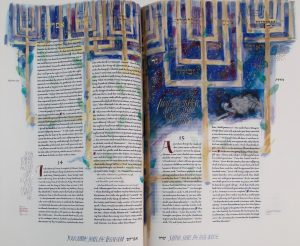
The Jewish “Festival of Lights,” Hanukkah, ends tomorrow night (Thursday, Dec. 5). A menorah (although not the type pictured here) figures prominently in Hanukkah celebrations, and so the library has chosen this illumination for our next display. It illustrates the story of God’s covenant with Abraham, in which God promises that Abraham and Sarah’s descendents will number as the stars. The menorahs become family trees, with the names of the twelve tribes of Israel among the branches at the top of the page and Abraham and Sarah’s names at the bottom.
In the night sky behind the family tree / menorahs, we see flashes of gold as the stars come out. You might also recognize the delicate lacy mandalas that accompanied night stars in another recent image: the Birth of Christ. So connections are made from one Saint John’s Bible image to another, and to all religions using mandalas in their worship.
Writer Susan Sink calls our attention to the black and grey figure to the bottom-right of the largest menorah, seeing in it “the sacrificial ram” which substitutes for Isaac, Abraham and Sarah’s son, whom God commanded Abraham to sacrifice in a test of his obedience. (Art of The Saint John’s Bible, Vol. 1, p. 24)
A note about the menorahs: Hanukkah celebrates a period in which a small amount of lantern oil lasted for 8 nights, much longer than expected. Hanukkah menorahs therefore hold a candle for each of those nights, with a ninth central candle used to light the others.